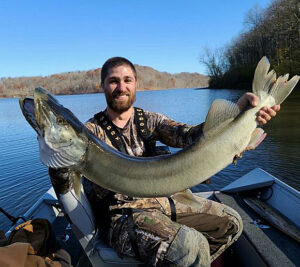
There’s no greater fun once you find it. Spring panfishing is as good as it gets. (Photo Provided by Author)
After a three month hiatus to re-educate, I’ve come home at the perfect time to catch big bluegills in southern Ohio. And what could be better?
By Ray Reilly for Press Pros fishing fans….
 If you’ve missed me I’ve been out among ’em, to at least six states since mid-February doing my due diligence, educationally, on topics ranging from gamebird habitat to finding fish where no one else even fishes, or suspects.
If you’ve missed me I’ve been out among ’em, to at least six states since mid-February doing my due diligence, educationally, on topics ranging from gamebird habitat to finding fish where no one else even fishes, or suspects.
The latter is the subject for my latest column…finding fish where others say, “Don’t bother.”
I recently joined a friend from West Virginia to fish outside of Ironton, Ohio, at Vesuvius Lake on Ohio route 93. Vesuvius is listed as an 143-acre body of water in the Wayne National Forest, and one of the Buckeye State’s most picturesque lakes, as pretty as you’ll ever find. And a lot of people have found it, because one of the knocks on it as a fishing spot is too many people, boats, and traffic in and out.
The other knock on it is…people say there aren’t many fish there to catch. But how can a 143-acre lake built in 1939 not have fish, I asked? My friend Blake Dickey called me one the road on night to say, “I’ve been there, and that no-fish ‘BS’ is just that, The trick is finding them, and I’ve done it.”
Six weeks ago we met in nearby Ironton at the Frisch’s restaurant for coffee before heading up the road – route 93 – to Lake Vesuvius.

Coverage of the outdoors on Press Pros is proudly sponsored by Olde English Outfitters, in Tipp City.
First impression…beautiful! Eye candy, whether you ever get a bite, or not. Blake assured me we’d get plenty of bites. But for the first fifteen minutes of being on the lake that morning you couldn’t prove it my me.
Vesuvius is navigable by boat, but you have to use an electric motor, which by my thinking, is preferable for fishing smaller bodies of water, anyway. Surrounded by timber and massive rock formations, we settled in on a spot with a visible dropoff, a perfect spot to find pre-spawn bluegill, and unleashed our lightweight spinning outfits and small jigs with a wax worm chaser.
Five minutes…no fish.
Ten minutes…no fish.
We hauled up anchor and made a tactical move to a sun-splashed point along the other side of that rock shelf. There, we finally hit paydirt.
“That’s got to be a bass,” I said to Blake, as my old lightweight St. Croix doubled over. And whatever it was…was persistent. A minute later I hauled to the surface a fat Redeared Sunfish that was just short of 10 inches. By the time I had him in the boat and had re-outfitted Blake’s rod was dancing wildly, too.
“I think this one’s bigger than yours,” he huffed, fearing that it would somehow shake free from that small jig and hook.
Finally, he got a hand on it and hauled it aboard by its lower lip…10 3/4 inches of the prettiest Sunfish you ever saw.
By now I was hooked up again, and soon had a second fish in the live well. Blake had barely got his jig back in the water before he was horsing another Sunfish as big as his first.
This continued for about 15 minutes…and then…nothing.
How could it be? A bonanza one minute and then suddenly…a bust.
 We switched tactics and began bait fishing with some night crawlers and in a hour and a half we caught three bass and some smaller bluegills – legit bluegills – and fun, but nothing like those first twenty minutes that yielded 15 of the biggest, scrappiest panfish I’d ever found.
We switched tactics and began bait fishing with some night crawlers and in a hour and a half we caught three bass and some smaller bluegills – legit bluegills – and fun, but nothing like those first twenty minutes that yielded 15 of the biggest, scrappiest panfish I’d ever found.
By the time we’d taken the boat out others were making their way to the launch area, and of course, a man in a red Ford truck asked if we’d had any luck. We showed him one of the Sunfish.
“That’s how it is here,” he said, a frequent visitor from nearby Ashland, Kentucky. “I’ve had some great days here, and a lot of others where you want to go home sell your boat. You never know.”
If you want to go, I’m confident that there are many, many more of the kind of bluegill and panfish that we found. We didn’t fish for crappies, but the Lake doesn’t have much of reputation for it, either. It does, however, have a reputation for 5 to 7 pound bass. And given the kind of bluegills we found, I can see why.
‘Til next time, I’ve enjoyed it.


